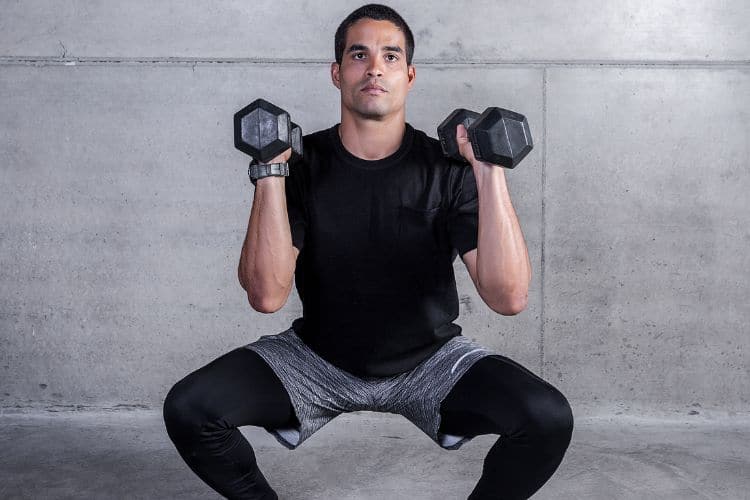
Full Body HIIT Gym Workout Plan – 45-Minute Power Circuit

Best 45 Minute Full Body Circuit Training Workout for Men

35-Minute Advanced Circuit Workout for Strength & Endurance

Best Full Body Circuit Weight Training Routine for Muscle
Dumbbell Squats for Men Build Stronger Legs at Home or the Gym

Dumbbell squats are one of the most effective lower-body exercises for men looking to build muscle, increase strength, and improve athletic performance. Whether you’re training at home, in a commercial gym, or using minimal equipment, dumbbell squats provide a functional, scalable workout option. In this guide, you’ll learn how to perform dumbbell squats with perfect form, explore different variations, and understand their muscle-building benefits for men at any fitness level.
Why Dumbbell Squats Are Essential for Men
Total-Leg Development
Dumbbell squats work the quadriceps, hamstrings, glutes, calves, and even your core. By using dumbbells instead of a barbell, you engage stabilizer muscles and reduce spinal compression, making it a safer yet still challenging squat variation.
Versatility and Accessibility
You don’t need a squat rack or heavy-duty gym to perform dumbbell squats. All you need are two dumbbells and a small amount of floor space. This makes them ideal for men training at home or looking to mix up their routine.
Functional Strength and Athleticism
Dumbbell squats mimic everyday movement patterns like sitting, standing, and lifting. This makes them excellent for building functional strength that carries over into sports, manual labor, and daily life.
Muscles Worked in Dumbbell Squats
When performed correctly, dumbbell squats recruit the following muscle groups:
- Quadriceps: The primary movers during the squat.
- Hamstrings and Glutes: Help extend the hips and stabilize your body.
- Calves: Engage during the standing phase.
- Core Muscles: Provide balance and stability.
- Lower Back: Assists in posture and control.
How to Perform a Basic Dumbbell Squat
Step-by-Step Instructions
- Start Position: Stand tall with feet shoulder-width apart. Hold a dumbbell in each hand at your sides or up at shoulder level for more core engagement.
- Brace the Core: Engage your core muscles and keep your chest up.
- Lower into a Squat: Push your hips back and bend your knees to lower your body. Keep your back straight and avoid letting your knees cave in.
- Depth: Lower until your thighs are parallel to the ground or deeper if flexibility allows.
- Return to Start: Press through your heels to stand back up, squeezing your glutes at the top.
- Repeat: Perform 3–4 sets of 8–12 reps for muscle building or 15–20 reps for endurance.
Common Mistakes to Avoid
Rounding the Back
Keep your spine neutral throughout the movement. Rounding your back can lead to injury.
Letting Knees Collapse Inward
Always track your knees over your toes. Use a mirror if needed to ensure proper alignment.
Holding Dumbbells Too Far Forward
Keep dumbbells close to your body. Holding them too far forward strains the shoulders and ruins your balance.
Best Dumbbell Squat Variations for Men
Goblet Squat
Hold one dumbbell vertically at chest height.
- Focus: Core activation and quad emphasis.
- Best For: Beginners and home workouts.
Dumbbell Front Squat
Hold two dumbbells at shoulder height (rack position).
- Focus: Quads and core stability.
- Best For: Intermediate to advanced lifters.
Dumbbell Bulgarian Split Squat
Place your rear foot on a bench and squat with dumbbells in hand.
- Focus: Glutes, hamstrings, balance.
- Best For: Advanced unilateral leg training.
Dumbbell Sumo Squat
Stand with feet wider than shoulder-width and toes turned out. Hold a single dumbbell between your legs.
- Focus: Inner thighs, glutes, quads.
- Best For: Variety and adductor development.
Dumbbell Overhead Squat
Hold two dumbbells overhead as you squat.
- Focus: Core, shoulders, total body coordination.
- Best For: Athletes and advanced lifters.
Sample Dumbbell Squat Workout for Men
Here’s a balanced lower-body workout using dumbbell squat variations:
Warm-Up:
- Bodyweight Squats – 2 sets of 15
- Walking Lunges – 2 sets of 10 per leg
Main Workout:
- Goblet Squat – 3 sets of 10–12 reps
- Bulgarian Split Squat – 3 sets of 8 reps per leg
- Dumbbell Front Squat – 3 sets of 10 reps
- Dumbbell Sumo Squat – 3 sets of 15 reps
- Calf Raises (with dumbbells) – 3 sets of 20 reps
Finisher (Optional):
- Dumbbell Jump Squats – 3 sets of 10 for explosiveness
Cooldown:
- Hamstring Stretch – 30 seconds per leg
- Quad Stretch – 30 seconds per leg
- Deep Squat Hold – 60 seconds
Benefits of Dumbbell Squats for Men
1. Muscle Hypertrophy
Dumbbell squats activate major muscle groups, promoting muscle growth (hypertrophy). When done progressively with increased weight and reps, they are excellent for bulking the legs and glutes.
2. Fat Burning
Dumbbell squats elevate your heart rate and burn calories during and after your workout. They’re great for men aiming to reduce body fat while building lean muscle.
3. Core Development
Holding weights during squats requires bracing and core control, especially in front-loaded versions like goblet or overhead squats.
4. Better Posture
Squats train the posterior chain, including the glutes and back, helping men correct poor posture from desk jobs and sedentary habits.
5. Athletic Enhancement
From sprinting to jumping and cutting, dumbbell squats train the essential mechanics used in sports and daily activities.
How to Progress Dumbbell Squats Over Time
Add Weight Gradually
Increase dumbbell weight as you get stronger. Aim for a 5–10% increase every 1–2 weeks.
Increase Volume
Do more sets or reps to challenge your muscles. For strength, go heavier with fewer reps; for endurance, go lighter with higher reps.
Combine Variations
Rotate between front squats, sumo squats, and split squats to prevent plateaus and keep workouts interesting.
Superset with Upper Body Movements
Pair squats with upper-body dumbbell exercises like rows or presses to create full-body supersets for strength and fat loss.
Dumbbell Squats vs. Barbell Squats
| Feature | Dumbbell Squats | Barbell Squats |
|---|---|---|
| Accessibility | Easier for home gyms | Requires squat rack |
| Spinal Load | Less compressive | Higher spinal compression |
| Core Engagement | Higher (especially in goblet/front) | Moderate |
| Balance and Stability | Greater due to dual weight distribution | Less stabilization required |
| Scalability | Limited by dumbbell size | More weight can be loaded |
Verdict: Dumbbell squats are ideal for men starting out or training at home. Barbell squats are better for max strength but come with greater injury risk and equipment needs.
When to Use Dumbbell Squats in Your Training Program
Beginner Training Plan
Use dumbbell squats as your primary leg movement. Focus on perfecting form and building strength.
Intermediate Plan
Incorporate dumbbell squats on leg days or total-body days. Combine with lunges, deadlifts, or plyometric movements.
Advanced Programming
Use dumbbell squats as accessory lifts after barbell squats or deadlifts. Try unilateral variations to fix imbalances and build symmetry.
Tips for Maximizing Dumbbell Squat Results
- Breathe Properly: Inhale before you descend, exhale as you drive up.
- Train 2–3 Times Per Week: Allow rest days in between for recovery and growth.
- Prioritize Form Over Weight: Master technique before increasing load.
- Stretch and Mobilize: Hip and ankle mobility improves squat depth and safety.
- Track Your Progress: Log weights, sets, and reps to measure strength gains.
Who Should Avoid Dumbbell Squats?
Men with:
- Severe knee injuries or joint issues
- Unstable lower back conditions
- Poor balance or coordination (unless supervised)
Should consult a physician or physical therapist before beginning a dumbbell squat program.
Final Tips on Dumbbell Squats for Men
Dumbbell squats are one of the most efficient and practical exercises for building leg strength, muscle size, and total-body athleticism. They’re simple enough for beginners and effective enough for advanced lifters. Whether your goal is fat loss, strength, or performance, incorporating dumbbell squats into your workout routine is a smart move.
With the ability to perform them anywhere, dumbbell squats are a must-have in every man’s training toolbox. Master the basics, experiment with variations, and stay consistent—your legs, core, and athleticism will thank you.
Most Recommended
Subscribe to our Newsletter
Stay up to date on the latest men’s health, fitness and lifestyle trends and tips.
About Us
Men’s Fit Club was started with the goal of empowering men to get the most out of their lives. This meant going beyond exercise and diet tips to really address the broad range of issues that men face on a daily basis – topics like recreation, finding love, sexual health and even sound fashion advice.
Quick Links
© COPYRIGHT MEN'S FIT CLUB 2025. All Rights Reserved

